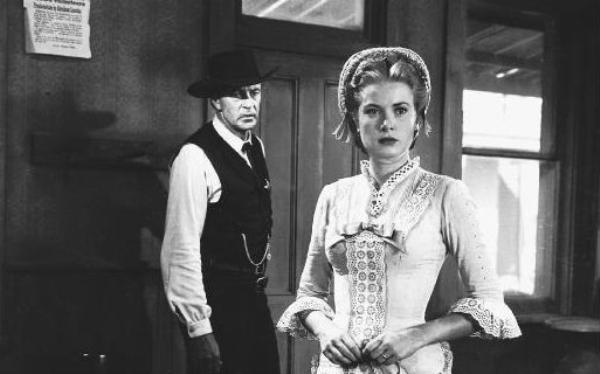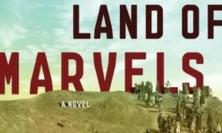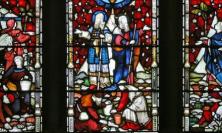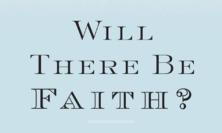The next of our ‘Virtues on Film’ for Lent is faith, and Karen Eliasen uses a classic Western to illustrate a characteristically Old Testament understanding of the virtue. The lyrics of the ‘simple but haunting cowboy ballad’ that is heard throughout High Noon express a plea that is at the heart of faith: ‘Do not forsake me, O my darlin’.’
A week or two before this year’s Ash Wednesday, I found myself paying especial attention to several of the first readings at the weekday Masses. In those readings leading up to the Lenten season, the writer of the Letter to the Hebrews goes on at length about the nature and practice of faith – especially the kind of faith that warriors have. ‘They were weak people who were given strength, to be brave in war and drive back foreign invaders,’ Heb 11:34 tells us after having offered several examples of familiar war heroes from the Old Testament, for the most part an altogether violent lot (Gideon, Samson, Jephthah, David).
These violent ‘heroes of faith’, as they are referred to in Hebrews, are a core component of Yahweh’s covenant with ancient Israel. All we have to do is read Deuteronomy to have this spelled out for us. On the eve of entry into the Promised Land to face a powerful enemy, Moses exhorts the Israelites (several times) to ‘be strong and bold; have no fear or dread of them, because it is the Lord who goes with you; he will not fail you or forsake you.’ (Dt 31:6). This God of Israel’s will not fail them because, as is made clear at the beginning of Deuteronomy, ‘the Lord your God is a merciful God, he will neither abandon you nor destroy you; he will not forget the covenant with your ancestors that he swore to them.’ I want to pick up on this Old Testament ‘threesome’ of faith, fear in the face of enemies, and covenant, and in particular on the sense of faith as a hope – a prayerful reminder of a vowed promise – that we will not be forsaken by God in those times when we feel most afraid for our very lives. In the Bible we are again and again asked to take to heart that the ultimate consolation a human being can have is to understand deeply and experientially that we are not forsaken by God. However metaphorically or literally we understand the whole story of Israel’s entry into the Promised Land, this kind of consolation remains a fundamental truth of faith life. We are not forsaken by God, and knowing that helps us to face, like weak people strengthened, the scariest of what life offers.
Fred Zinnemann’s classic 1952 Western High Noon readily lends itself to appreciating this aspect of faith. In the relationship between the film’s hero, an older violence-weary marshal (Gary Cooper at his pained and drawn best), and his new young wife (Grace Kelly at her pristine and elegant best), a riveting story unfolds. It is a story about faith, fear and wedding promises set amidst a typical Western violent reality, a reality which is clearly outlined already at the very beginning of the film in the song that accompanies the opening shots. This simple but haunting cowboy ballad goes right to the core of the hero’s dilemma – or rather, the wedded couple’s dilemma: ‘Do not forsake me, O my darlin’/On this our wedding day …’ sounds the first verse, lines repeated in the last verse: ‘Do not forsake me, O my darlin’/You made that promise when we wed …’. In between these psalm-like pleas, the ballad laments the hero’s turmoil within as he confronts the villain without: ‘If I’m a man I must be brave/And I must face that deadly killer …’, and then ‘I’m not afraid of death, but O,/What will I do if you leave me?’
This film does not end with a wedding and an idyllic settling down to domestic bliss; the wedding comes right at the beginning of the film, which then instead ends with a brief but shocking shoot-out in which both husband and wife take shooting action. Moreover, it is through the wife’s use of a gun that the husband’s life is saved. What makes this shoot-out so shocking is that the wife is a Quaker with strong anti-violence convictions. As we learn at the wedding itself, her husband is putting his marshal’s badge and violent ways behind him at her Quaker behest. But, as the introductory ballad makes clear, trouble quickly arises to challenge the promises of this marriage precisely in this matter of violence: a former gun-toting nemesis is arriving on the noon train. The news prompts the marshal to pick up his badge one final time, to which his new wife’s immediate response is to threaten to ‘forsake’ him. As it turns out, all the townspeople one by one refuse to stand by him in his need, and he is left alone to face the noon train. Hence the simple but haunting ballad.
This ballad, sung at the beginning, is resumed some two dozen times throughout the remaining 85 minutes of the film. It is an overwhelming musical presence that not only gives away the film’s basic and typical Western storyline of a shoot-out between good and evil, it also signals the film’s emphasis on something that was not at all typical of the Westerns of the time, namely the inner psychological dynamics of its hero – ‘If I’m a man, I must be brave’. Westerns are above all about a brave man, a hero. In the words of an early Western film critic, ‘this man with a gun and the impulse to use it rightly is the crux of the genre.’ But in High Noon, this typical Western hero’s impulse to settle violence with violence is given a new twist and undermined, as is the typical Western marriage.
These two themes, a violent hero and a committed marriage, are brilliantly and subversively brought into play with each other – serious play – in High Noon. Thus the film has as its hero someone who asks for help in confronting a threatening villain because he feels unable to do the job himself – the hero as a weak man, as Hebrews would have it, asking to be strengthened. And it has as its romantic interest a wife who is not a damsel in distress in need of heroic saving, but a conscientious woman seeking understanding, a woman who ultimately herself takes violent heroic action to save her husband. In the final shootout between good and evil from which all the townspeople have fled, she is there to fight; she too picks up a gun and shoots and kills. Being made in the image of Grace Kelly, she manages to emerge from this episode not an emasculating tigress, but a dignified and graceful woman of deeply-held convictions. Nevertheless, the shocking denouement in which the villain is killed is not one for celebration, as the returning townspeople believe. Rather, it is one for recognizing just how abhorrent violence, any violence, is. The hero now does finally put his badge behind him, with his wife at his side, but he does so contemptuously by throwing it down in the dust.
When the film first came out, not everyone was thrilled by this radical re-reading of the Western hero and his romantic interest. Howard Hawks, another well-known but conventional Western film-director of the time, put his finger centrally on why he hated these subverting aspects of High Noon. He didn’t think, ‘a good sheriff was going to run around like a chicken with his head cut off asking for help. And who saves him? His Quaker wife. That isn’t my idea of a good Western.’
There are two issues in this reaction to what does not make the High Noon story ‘a good Western’, or at least a typical Western, and both touch on how faith at its most experiential is at work – miraculously at work – in people who find themselves in life-and-death crises, times when our deepest convictions are stretched to their utmost. One issue is to do with a man who asks for help, asks not to be forsaken at a time when he is in mortal danger. The other issue is to do with a woman who discovers in herself a deep passion to not forsake when she most feels like forsaking. It is not so much that her convictions about violence are turned upside down, but much more that she has gained a profound awareness, an understanding even, not just of her husband as a man, but of violence as an existential reality. Both as a wife and as a Quaker, she is on a steep learning curve.
Again and again throughout the film, the wife expresses a direct desire to understand her husband’s motive for staying to confront the violence. As the film progresses, her husband’s answers to her increasingly heartfelt pleas of ‘I don’t understand’ get more and more vague. At first, it is a plain man answering: ‘They’re making me run; I’ve never run before.’ Then he shifts to a more pragmatic angle: ‘They’d just come after us, and we’d be all alone on the prairie.’ Then instinct sets in: ‘I’ve got to, that’s the whole thing.’ Eventually his answers take on a sullen inarticulateness: ‘If you don’t know, I can’t tell you.’ Finally he becomes outright emotional: ‘If you think I like this, you’re crazy!’
But if his wife does not immediately understand these answers, she eventually finds her way to another woman who does understand why her husband is staying. Again turning Western stereo-types upside down, High Noon shifts its narrative focus onto the relationship between the two women important to the hero: the young, slim, virginal, blonde and educated Eastern schoolmarm of a wife, and the older, ampler, sexually experienced, darker and streetwise Mexican saloon woman of an ex-mistress. The stereotypes are turned upside down because instead of engaging in the requisite cat fight over a man, the two exchange information with wonderful dignity and honesty. In this way, the young wife is helped to understand both her husband and what it means to live up to the promises she has made to him. ‘If Kane was my man,’ insists the ex-mistress, ‘I’d never leave him like this. I’d get a gun. I’d fight.’ The wife simply inquires, ‘Why don’t you?’ To which the truth-hitting answer rings out, ‘He is not my man. He is yours.’
The truth of this answer, set within a lengthy dialogue of mutual respect, finally sinks fully home when the two of them have boarded the train together to leave behind man and town and violence. As shots are heard, the wife is catapulted into the realisation of what she must do: not forsake her man, her man whom she has promised ‘to have and to hold until death do you part’. In some way her husband’s plea, his prayer, his searching faith in her as his wedded wife who has made such a promise to him, comes to fruition in this moment. ‘Do not forsake me, O my darling’ … and she hears him and she does not forsake him. Then they ride off together into married life.
It is not for nothing that the Old Testament makes such vivid use of the marriage metaphor to express both the passions and the promises that inform the relationship between Yahweh and Israel. And there is something about Westerns (all Westerns, really, not just High Noon) that taps into these very basic Old Testament themes about law and order and violence and men and women – and faith.
Karen Eliasen works in spirituality at Loyola Hall Jesuit Spirituality Centre, Rainhill.
‘Virtues on Film’ on Thinking Faith:
 The Saving Power of Christian Virtue in The Lord of the Rings by Catherine Hudak Klancer
The Saving Power of Christian Virtue in The Lord of the Rings by Catherine Hudak Klancer
 Fortitude in Of Gods and Men by Niall Keenan
Fortitude in Of Gods and Men by Niall Keenan
 Prudence in Star Trek by Simon Potter
Prudence in Star Trek by Simon Potter
 Justice in A Royal Affair by Nathan Koblintz
Justice in A Royal Affair by Nathan Koblintz
 Caritas in Quartet by Quentin de la Bédoyère
Caritas in Quartet by Quentin de la Bédoyère
 Hope in Life is Beautiful by Frances Murphy
Hope in Life is Beautiful by Frances Murphy
‘The Seven Deadly Sins on Film’ series on Thinking Faith:
 ‘The Seven Deadly Sins’ by Nicholas Austin SJ
‘The Seven Deadly Sins’ by Nicholas Austin SJ
 ‘Envy’ in Amadeus
‘Envy’ in Amadeus
 ‘Pride’ in The Talented Mr Ripley
‘Pride’ in The Talented Mr Ripley
 ‘Lust’ in Shame
‘Lust’ in Shame
 ‘Sloth’ in American Beauty
‘Sloth’ in American Beauty
 ‘Greed’ in Shallow Grave
‘Greed’ in Shallow Grave
 ‘Gluttony’ in Super Size Me
‘Gluttony’ in Super Size Me
 ‘Wrath’ in Shine
‘Wrath’ in Shine






